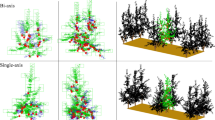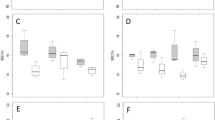Abstract
Improvement of light penetration within tree canopies has been a constant objective of fruit tree architecture manipulation through the setting up of training systems. Recently, centrifugal training, i.e. the removal of fruiting shoots in the tree centre and on the underside of branches, has been proposed to improve fruit size and colour as well as return-bloom as compared to conventional solaxe-trained trees with equivalent crop loads. The present study was conducted to quantify the benefits of centrifugal training on light interception by the fruiting shoots via computer-assisted three-dimensional representations of foliage geometry. Data were collected on six 5-year-old apple trees cv.Galaxy, trained either with solaxe or centrifugal training systems, using an electromagnetic 3D digitiser. The 3D distribution of the foliage in the tree canopy was recreated by combining both the spatial locations of shoots (as measured from 3D digitising) and foliage reconstruction. Light interception efficiency properties of the trees were characterised by silhouette to total area ratio (STAR) values computed from images of the 3D mock-ups. Compared to the solaxe system, centrifugal training significantly improved the STAR of the whole tree by 20%. It also increased both leaf area and STAR of the fruiting shoots by approximately 15%, regardless of their position in the canopy. In this paper, we discuss the role of this enhanced light interception by the canopy in increasing the autonomy of the fruiting shoot, i.e. improved fruit size and colour, and return-bloom.






Similar content being viewed by others
References
Abbott DL (1960) The bourse shoot as a factor in the growth of apple fruits. Ann Appl Biol 48:434–438
Adam B (1999) POL95—software to drive a Polhemus Fastrak 3 SPACE 3D digitiser. Version 1.0. UMR PIAF INRA-UBP, Clermont-Ferrand
Adam B, Sinoquet H, Dones N (2001) VegeSTAR—software to compute light interception and canopy photosynthesis from images of 3D digitised plants. Version 2.0. UMR PIAF INRA-UBP, Clermont-Ferrand
Barritt BH, Rom CR, Konishi BJ, Dilley MA (1991) Light level influences spur quality and canopy development and light interception influence fruit production in apple. HortScience 26:993–999
Corelli-Grappadelli L, Lakso AN, Flore JA (1994) Early season patterns of carbohydrate partitioning in exposed and shaded apple branches. J Am Soc Hortic Sci 119:596–603
Crete X, Lauri PÉ, Ferré G (2002) Pommier—influence de la date d’extinction sur les résultats agronomiques. Réussir Fruits Légumes 206:53–54
Den Dulk JA (1989) The interpretation of remote sensing, a feasability study. PhD thesis. Chapter 3—Turtle, Hare and soil model
Ferre G, Lauri PÉ, Crete X, Tarisse S (2002) Pommier—extinction, branche fruitière et maîtrise de la charge. Réussir Fruits Légumes 206:54–55
Ferree DC, Palmer JW (1982) Effect of spur defoliation and ringing during bloom on fruiting, fruit mineral level, and net photosynthesis of ‘Golden Delicious’ apple. J Am Soc Hortic Sci 107:1182–1186
Génard M, Baret F (1994) Spatial and temporal variation of light inside peach trees. J Am Soc Hortic Sci 119:669–677
Génard M, Baret F, Simon DA (2000) 3D peach canopy model used to evaluate the effect of tree architecture and density on photosynthesis at a range of scales. Ecol Model 128:197–209
Hansen P (1977) Carbohydrate allocation. In: Landsberg JJ, Cutting CV (eds) Environmental effects on crop physiology. Academic, London, pp 247–258
Jackson JE (1980) Light interception and utilization by orchard systems. Hortic Rev 2:208–267
Lakso AN (1980) Aspects of canopy photosynthesis and productivity in the apple tree. Acta Hortic 114:100–109
Lakso AN (1994) Apple. In: Schaffer B, Andersen PC (eds) Handbook of environmental physiology of fruit crops. Temperate crops, vol I. CRC, Boca Raton, pp 3–42
Lakso AN, Corelli-Grappadelli L (1992) Implications of pruning and training practices to carbon partitioning and fruit development in apple. Acta Hortic 322:231–239
Lakso AN, Wünsche JN, Palmer JW, Corelli-Grappadelli L (1999) Measurement and modelling of carbon balance of the apple tree. HortScience 34:1040–1047
Larrive G, Lauri PÉ, Lespinasse JM, Ramonguilhem M (2000) Conduite “centrifuge” avec extinctions. Réussir Fruits Légumes 182:46–48
Lauri PÉ, Kelner JJ (2001) Shoot type demography and dry matter partitioning. A morphometric approach in apple (Malus × domestica Borkh.). Can J Bot 79:1270–1273
Lauri PÉ, Lespinasse JM (1993) The relationship between cultivar fruiting-type and fruiting branch characteristics in Apple trees. Acta Hortic 349:259–263
Lauri PÉ, Lespinasse JM (1999) Apple tree training in France: current concepts and practical implications. Fruits 54:441–449
Lauri PÉ, Terouanne E, Lespinasse JM (1997) Relationship between the early development of apple fruiting branches and the regularity of bearing—an approach to the strategies of various cultivars. J Hortic Sci 72:519–530
Lauri PÉ, Willaume M, Larrive G, Lespinasse JM (2004) The concept of centrifugal training in apple aimed at optimizing the relationship between growth and fruiting. XXVI International Horticultural Congress: Key Processes in the Growth and Cropping of Deciduous Fruit and Nut Trees, Acta Hortic 636
Lespinasse JM (1996) Apple orchard management practices in France. From the vertical axis to the solaxe. Compact Fruit Tree 29:83–88
Lespinasse JM, Delort F (1986) Apple tree management in vertical axis: appraisal after ten years of experiments. Acta Hortic 160:120–155
Lespinasse JM, Delort JF (1993) Regulation of fruiting in apple. Role of the bourse and crowned brindles. Acta Hortic 349:229–246
MAFCOT (1999) Dossier conduite du pommier—Branche fruitière et extinction. Réussir Fruits Légumes 173:27–34
Mierowska A, Keutgen N, Huysamer M, Smith V (2002) Photosynthetic acclimation of apple spur leaves to summer pruning. Sci Hortic 92:9–27
Moon P, Spencer DE (1942) Illumination from a non-uniform sky. Trans Illumin Eng Soc 37:707–712
Palmer JW (1980) Computed effects of spacing on light interception and distribution within hedgerow trees in relation to productivity. Acta Hortic 114:80–88
Palmer JW, Warrington IJ (2000) Underlying principles of successful apple planting systems. Acta Hortic 513:357–363
Pratt C (1990) Apple trees: morphology and anatomy. Hortic Rev 12:265–305
Quinlan JD, Preston AP (1971) The influence of shoot competition on fruit retention and cropping of apple trees. J Hortic Sci 46:525–534
Sansavini S, Corelli-Grappadelli L (1992) Canopy efficiency of apple as affected by microclimatic factors and tree structure. Acta Hortic 322:69–77
Sinoquet H, Bonhomme R (1992) Modeling radiative transfer in mixed and row intercropping systems. Agric For Meteorol 62:219–240
Sinoquet H, Rivet P (1997) Measurement and visualization of the architecture of an adult tree based on a three-dimensional digitising device. Trees 11:265–270
Sinoquet H, Rivet P, Godin C (1997) Assessment of the three-dimensional architecture of walnut trees using digitising. Silva Fenn 31:265–273
Sinoquet H, Thanisawanyangkura S, Mabrouk H, Kasemsap P (1998) Characterization of the light environment in canopies using 3D digitising and image processing. Ann Bot 82:203–212
Sinoquet H, Le Roux X, Adam B, Ameglio T, Daudet FA (2001) RATP, a model for simulating the spatial distribution of radiation absorption, transpiration and photosynthesis within canopies: application to an isolated tree crown. Plant Cell Environ 24:395–406
Stenberg P (1996) Simulations of the effects of shoot structure and orientation on vertical gradients in intercepted light by conifer canopies. Tree Physiol 16:99–108
Takenaka A (1994) Effects of leaf blade narrowness and petiole length on the light capture efficiency of a shoot. Ecol Res 9:109–114
Tarisse S (2001) Modifications expérimentales de la croissance et de la fructification du pommier (Malus × domestica Borkh. cv Galaxy) par la suppression sélective des organes fructifères (extinction artificielle). Diplôme d’ingénieur. Faculté universitaire des sciences agronomiques de Gembloux
Tustin DS, Hirst PM, Warrington IJ (1988) Influence of orientation and position of fruiting laterals on canopy light penetration, yield, and fruit quality of ‘Granny Smith’ apple. J Am Soc Hortic Sci 113:693–699
Tustin DS, Cashmore WM, Bensley RB (1998) The influence of orchard row canopy discontinuity on irradiance and leaf area distribution in apple trees. J Hortic Sci Biotechnol 73:289–297
Volz RK, Ferguson IB, Hewett EB, Wooley EW (1994) Wood age and leaf area influence fruit size and mineral composition of apple fruit. J Hortic Sci 69:385–395
Wagenmakers PS, Nijsse F, De Gendt CME (1991) Planting systems and light climate. Research Station for Fruit Growing, Wilhelminadorp, The Netherlands. Ann Rep 39–40
Wünsche JN, Lakso AN (2000) The relationship between leaf area and light interception by spur and extension shoot leaves and apple orchard productivity. HortScience 35:1202–1206
Wünsche JN, Lakso AN, Robinson TL, Lenz F, Denning SS (1996) The bases of productivity in apple production systems: the role of light interception by different shoot types. J Am Soc Hortic Sci 12:886–893
Acknowledgements
We would like to thank G. Ferré (CEHM), S. Tarisse (student) and J.-C. Salles (INRA) for setting up the experiment and technical support in the orchard, and B. Adam, N. Donès (UMR PIAF, INRA-Université Blaise-Pascal) and J.-J. Kelner for computer and material assistance.
Author information
Authors and Affiliations
Corresponding author
Rights and permissions
About this article
Cite this article
Willaume, M., Lauri, PÉ. & Sinoquet, H. Light interception in apple trees influenced by canopy architecture manipulation. Trees 18, 705–713 (2004). https://doi.org/10.1007/s00468-004-0357-4
Received:
Accepted:
Published:
Issue Date:
DOI: https://doi.org/10.1007/s00468-004-0357-4




